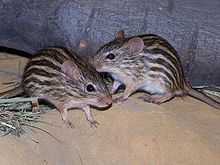Striped grass mouse
| Striped grass mice Temporal range: Late Pliocene to Recent | |
|---|---|
 | |
| Lemniscomys barbarus | |
| Scientific classification | |
| Kingdom: | Animalia |
| Phylum: | Chordata |
| Class: | Mammalia |
| Order: | Rodentia |
| Family: | Muridae |
| Subfamily: | Murinae |
| Genus: | Lemniscomys Trouessart, 1881 |
| Species | |
|
11, see text | |
Lemniscomys, sometimes known as striped grass mice or zebra mice, is a genus of murine rodents from Africa. Most species are from Sub-Saharan Africa; L. barbarus is the only found north of the Sahara.[1] They are generally found in grassy habitats, but where several species overlap in distribution there is a level of habitat differentiation between them.[1]
They are 18.5–29 cm (7.3–11.4 in) long, of which about half is tail, and weigh 18–70 g (0.63–2.47 oz).[1] The pelage pattern of the species fall into three main groups: The "true" zebra mice with distinct dark and pale stripes (L. barbarus, L. hoogstraali and L. zebra), the spotted grass mice with more spotty/interrupted stripes (L. bellieri, L. macculus, L. mittendorfi and L. striatus), and the single-striped grass mice with only a single dark stripe along the back (L. griselda, L. linulus, L. rosalia and L. roseveari).[2][3]
They are generally considered diurnal, but at least some species can be active during the night.[3] They feed on plants, but sometimes take insects.[1] There are up to 12 young per litter, but 4–5 is more common.[3] The average life expectancy is very short, in the wild often only a year, but a captive L. striatus lived for almost 5 years.[3] A more typical captive life expectancy is 2–2½ years.[4]
While most are common and not threatened, L. mittendorfi is restricted to Mount Oku and considered Vulnerable by the IUCN.[5] L. hoogstraali and L. roseveari are both very poorly known, leading to their rating as Data Deficient.[6][7] Some of the widespread species are regularly kept in captivity, especially L. barbarus, L. striatus and L. zebra.[4]
Species
Lemniscomys currently includes 11 species.[8] Until 1997, L. zebra was generally treated as a subspecies of L. barbarus.[2] It is possible L. striatus and L. zebra, as presently defined, actually are species complexes.[9][10]
- Lemniscomys barbarus (Linnaeus, 1766) — Barbary striped grass mouse
- Lemniscomys bellieri Van der Straeten, 1975 — Bellier's striped grass mouse
- Lemniscomys griselda (Thomas, 1904) — Griselda's striped grass mouse
- Lemniscomys hoogstraali Dieterlen, 1991 — Hoogstraal's striped grass mouse
- Lemniscomys linulus (Thomas, 1910) — Senegal one-striped grass mouse
- Lemniscomys macculus (Thomas and Wroughton, 1910) — Buffoon striped grass mouse
- Lemniscomys mittendorfi Eisentraut, 1968 — Mittendorf's striped grass mouse
- Lemniscomys rosalia (Thomas, 1904) — single-striped grass mouse
- Lemniscomys roseveari Van der Straeten, 1980 — Rosevear's striped grass mouse
- Lemniscomys striatus (Linnaeus, 1758) — typical striped grass mouse
- Lemniscomys zebra (Heuglin, 1864) — Heuglin's striped grass mouse
References
- ↑ 1.0 1.1 1.2 1.3 Kingdon, J. (1997). The Kingdon Field Guide to African Mammals. pp. 212-213. ISBN 0-12-408355-2
- ↑ 2.0 2.1 Carleton, M D., and Van der Straeten, E. (1997). Morphological differentiation among Subsaharan and north African populations of the Lemniscomys barbarus complex (Rodentia : Muridae). Proceedings of the Biological Society of Washington 110(4): 640-680.
- ↑ 3.0 3.1 3.2 3.3 Novak, R. M., editor (1999). Walker's Mammals of the World. Vol. 2. 6th edition. pp. 1596-1597. ISBN 0-8018-5789-9
- ↑ 4.0 4.1 Tofts, Russel. Striped Mouse. Striped Mouse Archived September 6, 2007 at the Wayback Machine
- ↑ van der Straeten, E. (2008). "Lemniscomys mittendorfi". IUCN Red List of Threatened Species. Version 2011.2. International Union for Conservation of Nature. Retrieved 10 December 2011.
- ↑ van der Straeten, E. (2008). "Lemniscomys hoogstraali". IUCN Red List of Threatened Species. Version 2011.2. International Union for Conservation of Nature. Retrieved 10 December 2011.
- ↑ van der Straeten, E. (2008). "Lemniscomys roseveari". IUCN Red List of Threatened Species. Version 2011.2. International Union for Conservation of Nature. Retrieved 10 December 2011.
- ↑ Wilson, D. E.; Reeder, D. M., eds. (2005). Mammal Species of the World (3rd ed.). Johns Hopkins University Press. ISBN 978-0-8018-8221-0. OCLC 62265494.
- ↑ van der Straeten, E. (2008). "Lemniscomys striatus". IUCN Red List of Threatened Species. Version 2011.2. International Union for Conservation of Nature. Retrieved 10 December 2011.
- ↑ van der Straeten, E. (2008). "Lemniscomys zebra". IUCN Red List of Threatened Species. Version 2011.2. International Union for Conservation of Nature. Retrieved 10 December 2011.
External links
| Wikimedia Commons has media related to Striped grass mouse. |
- Lemniscomys entry in Animal Diversity Web
- Lemniscomys entry in "The Taxonomican (does not include the species Lemniscomys zebra)
- Lemniscomys zebra entry in "Zipcode Zoo" (with links to entries for other Lemniscomys species and subspecies)